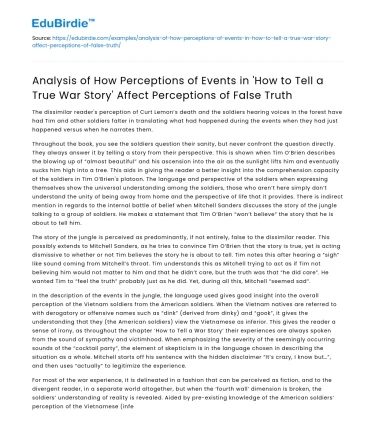The dissimilar reader's perception of Curt Lemon’s death and the soldiers hearing voices in the forest have had Tim and other soldiers falter in translating what had happened during the events when they had just happened versus when he narrates them.
Throughout the book, you see the soldiers question their sanity, but never confront the question directly. They always answer it by telling a story from their perspective. This is shown when Tim O’Brien describes the blowing up of “almost beautiful” and his ascension into the air as the sunlight lifts him and eventually sucks him high into a tree. This aids in giving the reader a better insight into the comprehension capacity of the soldiers in Tim O’Brien's platoon. The language and perspective of the soldiers when expressing themselves show the universal understanding among the soldiers, those who aren’t here simply don’t understand the unity of being away from home and the perspective of life that it provides. There is indirect mention in regards to the internal battle of belief when Mitchell Sanders discusses the story of the jungle talking to a group of soldiers. He makes a statement that Tim O’Brien “won’t believe” the story that he is about to tell him.
Save your time!
We can take care of your essay
- Proper editing and formatting
- Free revision, title page, and bibliography
- Flexible prices and money-back guarantee
The story of the jungle is perceived as predominantly, if not entirely, false to the dissimilar reader. This possibly extends to Mitchell Sanders, as he tries to convince Tim O’Brien that the story is true, yet is acting dismissive to whether or not Tim believes the story he is about to tell. Tim notes this after hearing a “sigh” like sound coming from Mitchell’s throat. Tim understands this as Mitchell trying to act as if Tim not believing him would not matter to him and that he didn’t care, but the truth was that “he did care”. He wanted Tim to “feel the truth” probably just as he did. Yet, during all this, Mitchell “seemed sad”.
In the description of the events in the jungle, the language used gives good insight into the overall perception of the Vietnam soldiers from the American soldiers. When the Vietnam natives are referred to with derogatory or offensive names such as “dink” (derived from dinky) and “gook”, it gives the understanding that they (the American soldiers) view the Vietnamese as inferior. This gives the reader a sense of irony, as throughout the chapter ‘How to Tell a War Story’ their experiences are always spoken from the sound of sympathy and victimhood. When emphasizing the severity of the seemingly occurring sounds of the “cocktail party”, the element of skepticism is in the language chosen in describing the situation as a whole. Mitchell starts off his sentence with the hidden disclaimer “It’s crazy, I know but…”, and then uses “actually” to legitimize the experience.
For most of the war experience, it is delineated in a fashion that can be perceived as fiction, and to the divergent reader, in a separate world altogether, but when the ‘fourth wall’ dimension is broken, the soldiers’ understanding of reality is revealed. Aided by pre-existing knowledge of the American soldiers’ perception of the Vietnamese (inferior), the reality shown makes the realization starker. The sounds of a “hoity-toity” party and the uncivilized now “civilized” leads them to conclude that where they are isn’t “civilized”, but they are in “Nam”, where civilization is just a mere remembrance of where they used to be, and where the reader is possibly reading from.
Proceeding in Mitchell Sanders’ story, the soldiers hearing in from the jungle call in enemy movement, “a whole army” they claimed. The US army proceeds to bring in “arty” (artillery), armed “gunships”, and fighter aircraft, napalming all directional walks of the “ridge”, making apparent “jungle juice” out of it. They then proceed to set the area ablaze. When the soldiers are then asked to explain the call for the attack, they remain silent. They couldn’t express themselves. This relates to a similar discussion from an analysis, written by Alex Vernon in his ‘Salvation, Storytelling, and Pilgrimage in Tim O'Brien's ‘The Things They Carried’’; he discusses the possibility of Tim, the character, and O’Brien, the author… whether this communication of the war experience is sufficient for quieting his own demons. The translation for this text is if the communication would suffice to express what the soldiers had to endure and possibly if they can even communicate their experience which would make them struggle to speak their truth.
The chapter ‘How to Tell a War Story’ is a constant reminder from the author Tim O’Brien that the only truth is in the words of fictional characters. This also includes the character Tim O’Brien, as he is named after the author, but is just as fictional as the others. The authenticity of the experiences solely relies on the reader’s interpretation of the text and how it was written. The name of the chapter is a reminder that no matter the intensity of the chapter’s influence, all experiences are of fictional origin.
In conclusion, the soldiers’ descriptive perspective is a great source of understanding how they utilize scenic descriptive words in a need to communicate their perception of traumatizing events. We also gain insight into the method of giving unconventional descriptions of typically terrifying events to get the reader to understand the callus that was built by the soldiers. The author Tim O’Brien used a fictional version of himself, which only helps reinforce the moral of ‘How to Tell a True War Story’, which is that the truth is what you make it out to be.






 Stuck on your essay?
Stuck on your essay?

